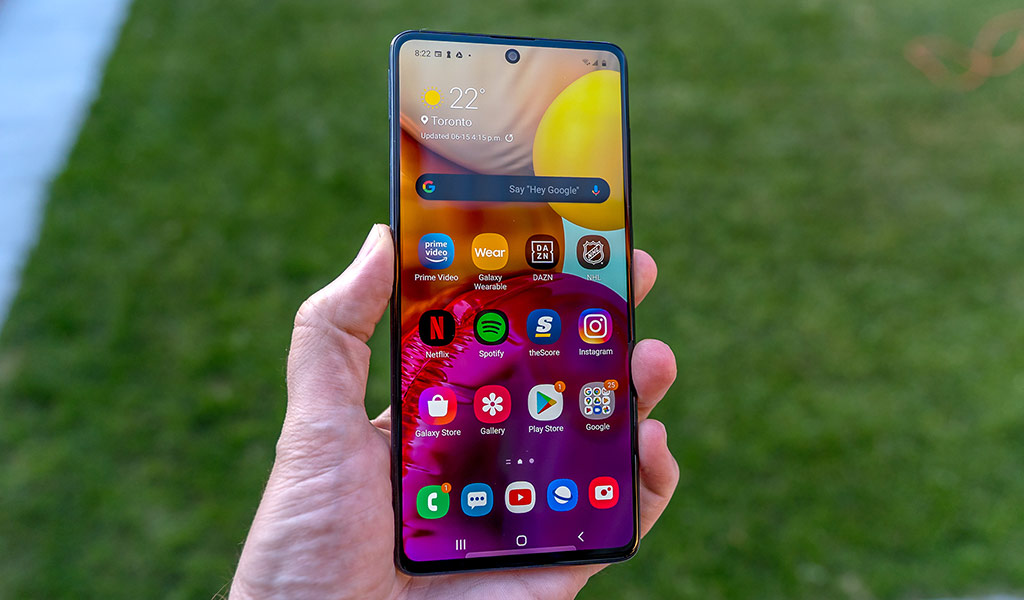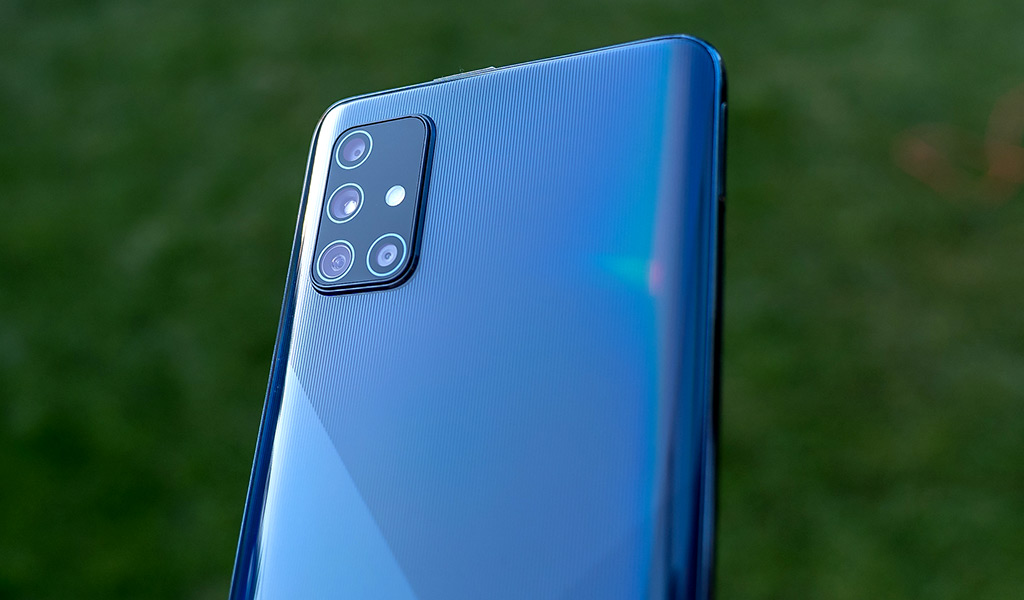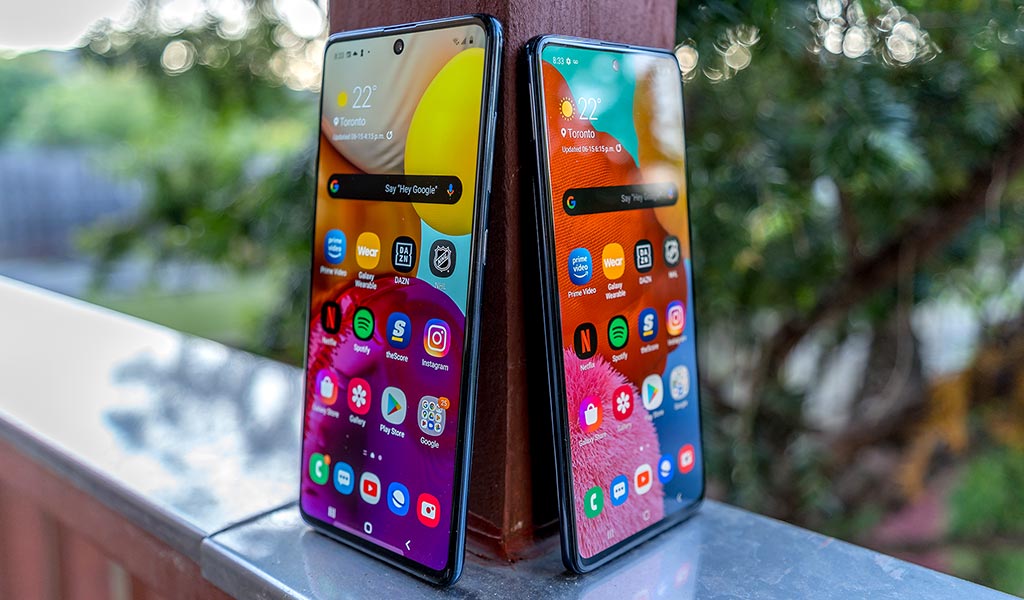
The Samsung Galaxy A71 is the mid-range smartphone that could make you feel like it delivers more than you bargained for.
For a company that usually makes headlines for its flagship models, like the recent Galaxy S20 line, Samsung has paid renewed attention to its mid-range devices. Last year’s Galaxy A line was a solid step in redefining its direction and purpose for handsets in this range. This year, the Galaxy A71 is paired with the Galaxy A51. I got to test both separately, and there are some distinct differences between them. For this review, I’m focusing on the Galaxy A71.
Samsung Galaxy A71 SpecsDisplay: 6.7-inch 2400 x 1080 Super AMOLED Plus display 20:9 aspect ratio with 393 pixels per inch |
Design
Samsung is also getting better at how it interprets what a mid-range phone should look and feel like. There are certain elements about the Galaxy A71 that lend it some credibility to being something more. Put this phone next to the Galaxy S20 lineup and it wouldn’t feel out of place. Naturally, they aren’t the same once you break down the various components between them, but this isn’t a dull phone.
The “Glasstic” build is back, and in melding glass with plastic together, Samsung arguably achieved the desired effect better this time around. Maybe it’s just me, but this phone felt a little more premium to me than last year’s model did.
It doesn’t hurt that the 6.7-inch Super AMOLED Plus display is really vibrant and eye-catching. Granted, its lower resolution is no match for the premium models, but it’s on par with what a mid-ranger should have. The size alone is the same as the Galaxy S20+, so this is a big screen by any reasonable standard.
On the inside, specs walk the same line. The Snapdragon 730 processor is good for a phone like this, and the RAM is also decent. Internal storage ranges between the 64GB and 128GB models, though a microSD card slot can expand that further. You even get a headphone jack for your troubles, in case that’s useful to you.
The rear camera array has no less than four different lenses, anchored by the main 64-megapixel image sensor that should be capable of taking great photos. More on that later. On the front is a 32-megapixel camera that aims to improve selfies, though I found it had a better impact on video calls.
Performance and software
Samsung’s One UI 2.0 took what was already a well-intentioned software rethink and improved it further. It’s a nice carryover from Samsung’s other phones, especially because its cleaner look and arrangement suits a phone like the Galaxy A71.
It took a while, but Samsung finally realized how critical hardware-software synergy truly is. And it’s one reason why mid-range handsets tend to follow the flagships. While I would hesitate to say the experience is at the same level as the Galaxy S20 models I tested, I had few problems doing what I wanted on this phone.
I could check email, browse a few sites, check out Twitter and then play music or stream video without a second thought. At no point did I notice anything slow down or lag along the way. For more intensive apps, like Adobe Lightroom or Snapseed, it managed well, though I made sure not to have too many other apps open. Playing games followed a similar pattern, where anything casual or reasonably graphics-intensive performed well. The more demanding the game, however, the greater the chance of a performance hit.

Camera
With four lenses to shoot with, the Galaxy A71 should produce worthy images. You would be right to expect that from a phone like this, even if the camera won’t quite match a flagship’s output. Much of what Samsung put in the S20 phones is available here, at least as it relates to the software.
The lenses and image sensors are different, so results will undoubtedly come out looking different. For the most part, the main lens, whether you shoot at 64 or 12-megapixels, manages good dynamic range and fairly rich colours.
Samsung’s penchant for processing images shows no matter what lens you shoot with. It won’t matter as much if you’re just sharing pics with friends and social media, and that may be partly the point. When I use any phone camera, I usually prefer to use specialized modes for greater control over composition. It’s just that Samsung limits them to a certain degree. For instance, Pro mode is limited to ISO, white balance and exposure compensation. Crucially missing is shutter speed, making it more difficult to shoot in certain situations.
Being a mid-range phone, I can understand cutting corners. It’s just unfortunate, considering Huawei doesn’t do the same thing with its phones at the same price point. The good news is that Samsung’s Night mode is included, and it works relatively well. It wisely doesn’t shoot at 64-megapixels to utilize larger pixels, and also works with both the wide and ultra-wide lenses. I just wish Samsung would finally let users use multiple lenses in Pro mode.
For basic shots, especially in ideal conditions, results will be very good. Live Focus and Food are pretty good, whereas Macro is a mixed bag.

Battery life
The 4500mAh battery, coupled with the combination of components, all but ensures that the Galaxy A71 will last throughout the day. In fact, you may even stretch it out to two days if you’re really moderate with your usage. Even if you stream music on it throughout the day, you probably won’t have to recharge until the next day.
Samsung includes a 25W charger in the box, which is important for two reasons. First, the phone doesn’t support wireless charging. Second, the included charger can fast charge it from zero to full in about 60 minutes.
Final thoughts
If you already have the Galaxy A70, I wouldn’t recommend upgrading to this model. But if you have an older phone, and are looking to upgrade, this is a good place to look. The Galaxy A71 is what a mid-range phone should be in a number of aspects. It has a great screen, excellent battery life, fluid software and dependable camera. This is hundreds less than what a flagship would cost, and it’s hard to argue with that.
The Samsung Galaxy A71 is available now.













